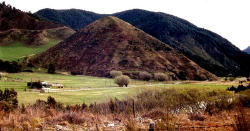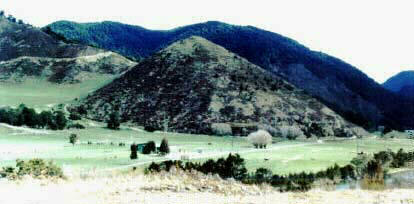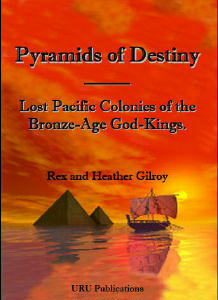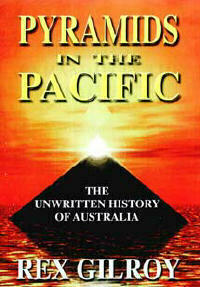
| Pyramids of Destiny – Lost Pacific Colonies of the Bronze-Age God-Kings |
 |
New Zeland Pyramid Mountain
Photo copyright © Rex Gilroy 2008. |
Pyramids of Destiny – Lost Pacific Colonies of the Bronze-Age God-Kings
by Rex & Heather Gilroy
Copyright
© Rex Gilroy 2009
| “Australian history is almost always picturesque; indeed it is so curious and strange, that it is itself the chiefest novelty the country has to offer, and so it pushes all other novelties into second and third place. It does not read like history but like the most beautiful lies. Mark Twain: Following the Equator [1891] |
”Every truth passes through three stages before it is recognised. In the first, it is ridiculed. In the second, it is opposed. In the third, it is regarded as self evident.” Arthur Schopenhauer [1788-1860] |
Part Six.
Egypto-Phoenicians in the Pacific.
Chapter Thirty Nine.
God-Kings of the New World.In the wake of the establishment of the New Zealand Pharonic Kingdom, fleets of treasure-seeking ships were dispatched to seek pearls, precious metals and gemstones in the Pacific Islands.
The explorers had to have possessed maps and other information from an earlier time, for they certainly seem to have known where they were sailing.
Wherever they landed and found rich supplies of what they sought, colonies soon sprang up, enlarged by reinforcements from New Zealand. This is not to say that many islands were not settled by colonists from Australia about this time. By whichever kingdom, the spread of Egypto-Phoenician culture eastwards across the Pacific, resulted in the colonisation of the Americas, and this can be said to have been the third and final great colonisation movement of these people.
We have already seen in previous chapters that the Bronze-Age colonists settled some islands more than others, depending upon the supply of pearls, precious metals etc.
Sometimes shipwreck gave mariners no choice as to whether they would settle an island. In 1870 one Richard Taylor discovered an Egyptian inscription on Pitcairn Island, which when his discovery was announced, caused a sensation, for it suggested that seafarers from the Old World had crossed the Indian and Pacific Oceans long centuries before the rise of later European world exploration. Ever since then cultural diffusionists have sought to pierce the veil of time, to discover the full extent of cross Pacific voyages by the ancients.
In 1963 ageing rock inscriptions were found at Luahiwa on the Island of Lanai, and also at Kii and Kau, Hawaii, believed to be Egyptian, or else engraved by Libyan hands under Egyptian direction. The Pitcairn inscription was translated by the renowned epigrapher, the late Dr Barry Fell in 1974, to read:
“Our crew, wrecked in a storm, made land, thank God!
We are people from the manu region.
We worship Ra in accordance with the scripture.
We behold the Sun and give voice”.The inscriptions are a mixture of Egyptian and Libyan. Dr Fell dated them to around 250 BC. He showed them to be Egyptian language and Libyan dialect. His dating suggested to many researchers at the time that Ptolemaic Egyptian and Libyan explorers were present in the Pacific Islands some 600 years before the main Polynesian migration from Java entered the Pacific.
By the same token, could these inscriptions have been the work of explorers from the Australian and/or New Zealand kingdoms? Further examples of Egyptian/Libyan rock inscriptions found in the Indonesian archipelago resulted in a mixing of these tongues with that of Polynesian, out of which another mixed script developed, to subsequently spread across Polynesia.
Petroglyphs found engraved at Dakumba, Fiji in “Libyan Maori” and dated to approximately 250 BC by Dr Fell speak of attacks in Tonga, and of the failure to colonise Fiji:
“Colonists worn out by attacks of the Nubians*,
withdrawn south to Tonga to settlement Bay.
Follow us therefore without delay.
Seed corn rotted in the bins.
Provisions exhausted.
Dependent on just our fish catch and wild herbs.
By orders of the commander”
[*local Melanesian natives].Libyans accompanied the Egypto-Phoenician and Celtic Bronze-Age voyages of colonisation into Australian and later New Zealand waters as we have already seen. And the admixture of these races saw a new racial character appear among the colonists, which would have been very evident by the time of the Ptolemies in the Egyptian homeland.
The racial character of these same peoples who established the New Zealand kingdom would not only have begun to change through race-mixing among themselves, but also through mixing with the Polynesians once they began arriving there. Ultimately this racial intermixture would have led to the breaking down of the original culture, hence one major reason for its disappearance.
Main Book Index | Mysterious Australia Homepage | URU Homepage | Australian Yowie Research Centre

